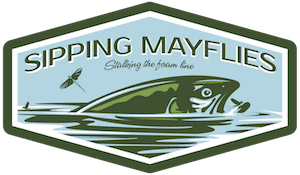FLY FISHING FOR CARP | FLIES AND TACTICS
Dec. 5th, 2024
I know why you’re here. You want to hear your reel screaming for mercy, and feel a deep bend in your rod. Carp will do both of those things, but you’ll have to earn it.
Before we get into the specific techniques and tactics of fly fishing for carp, let’s learn more about this misunderstood fish.
Catching carp on a fly isn’t easy, I’m not going to lie to you. It takes some research and preparation, but it’s certainly not complicated. In this article I’ll teach you everything you need to know, and you’ll have one of these fish on the end of your line in no time.
I’ll focus on the common carp (scientific name: Cyprus carpio), which is also called a European carp. But, I’ll also talk about the Grass carp (scientific name: Ctenopharyngodon idella), also known as a white amur.
Hooking into a big carp is nothing short of exhilarating, and worth all the effort. A large carp can put you into your backing with at least one long, deep run. There are few commonly found freshwater fish as rewarding on a fly rod. But first, let’s familiarize ourselves with this species.
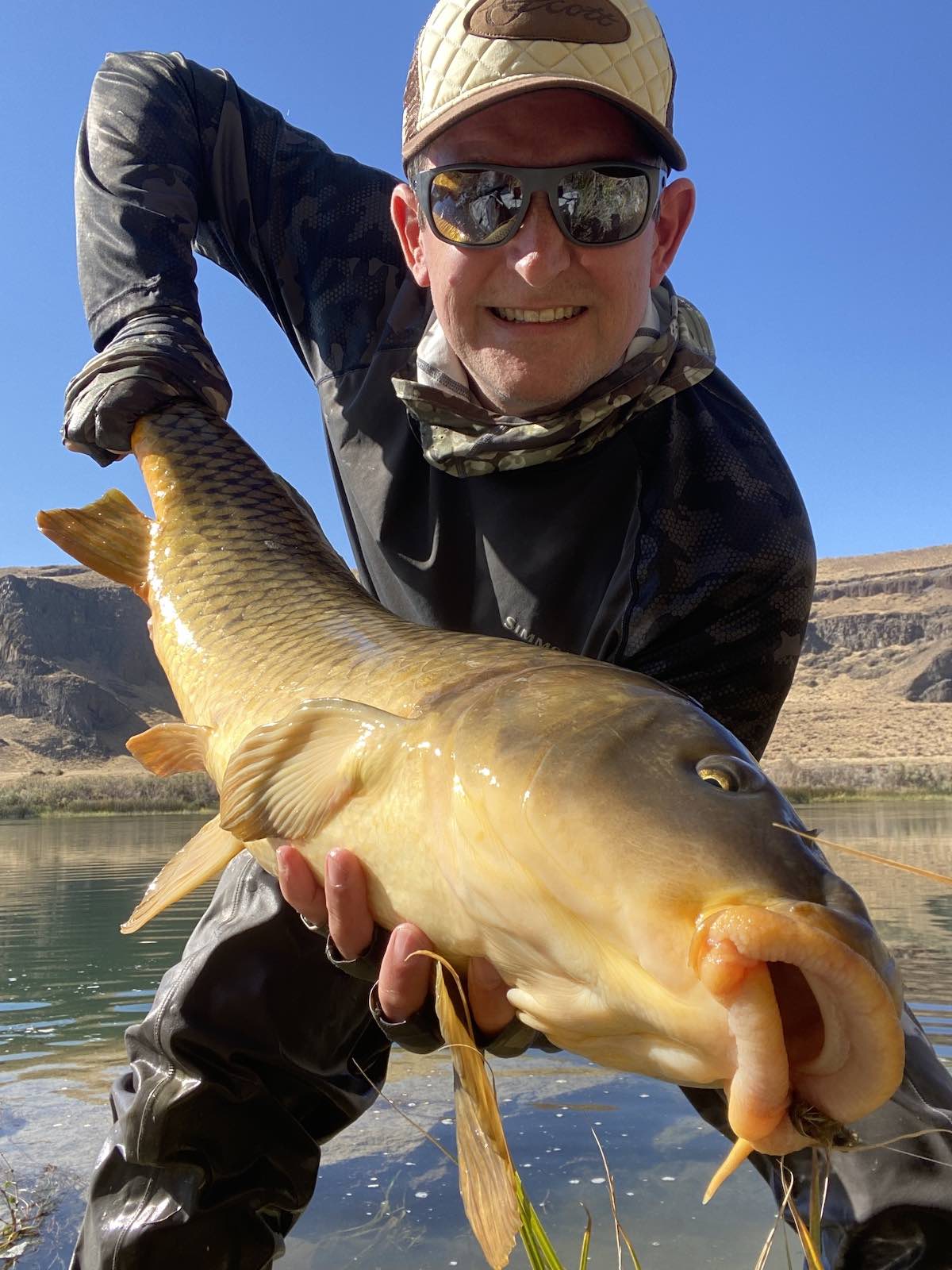
Here’s a monster common carp I caught while fly fishing on the Snake river. I was using a small weighted streamer pattern from the shoreline. I didn’t weigh or measure this fish (I rarely do), but it was a huge fish.
Introduction to Carp
Carp are often referred to as “Freshwater Bonefish” in fly fishing communities. It’s a tongue-in-cheek nickname with merit, because of the following commonalities between the two fish:
- Carp are usually found patrolling the shallows in search of food
- Their tails often break the water’s surface as they forage
- They’re generally shy and challenging to catch
- You generally sight-fish for them
- They can put up a tremendous fight
Carp are actually an invasive species in America; they’re endemic to Asia and Europe. In fact, carp were originally a luxury food fish in Europe. When they were brought to America, their numbers grew quickly and they often inhabited slower, dirtier, or more stagnant waters.
Eventually, this association coupled with how common they were, led to a very poor reputation within fishing circles. Even from a young age, most fishermen and women in the U.S. consider carp a “trash fish,” which is unfortunate and unwarranted.
Part of what makes carp so prolific is that they can withstand very warm water, and very cold water (although they generally won’t take your fly in cold water). These fish don’t prefer warm water (over 90F degrees), but they can handle it for long periods. In other words, they’re tough fish.
They’re actually on the list of the top 100 worst invasive species in the world.
There’s one type of carp that’s very popular in the U.S., and it’s called a Koi. Yes, koi are just domesticated common carp with more coloration and slight scale differences. I’ve never fly fished for koi, but there’s a first time for everything.
Carp were actually farmed dating all the way back to the Romans, and are still propagated around the world today for their meat, which is considered a delicacy in some places.
Ok, now that you’re more knowledgeable about carp than 99% of people, let’s get on with it.
Here’s a picture I took of some spawning common carp in early April. Each arrow points to a massive female carp.
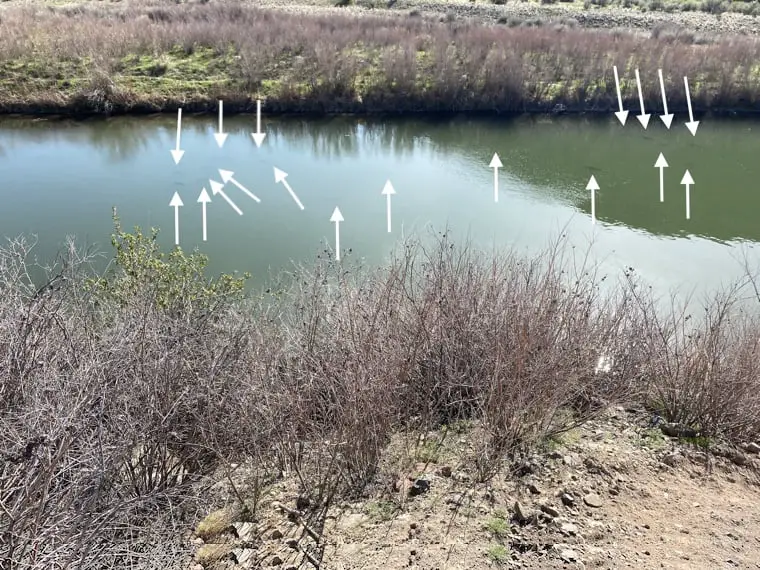
Common Carp Size
There are essentially two types of common carp: the domesticated ones (farmed), and the wild ones. We’ll focus on the wild ones since we’re fly fishing for them in nature, not fish farms. The reason I mentioned the two types is because the farmed carp understandably get much larger than the wild carp because of ever-present food, ideal conditions, and zero predators.
The common carp you’re going to find in your local rivers, lakes, and ponds will generally be in the 14 to 35 inch range, and weigh anywhere from 4 to 32 pounds.
The world record wild common carp was caught in Hungary and weighed-in at 112 pounds. The fish looks grotesquely fat.
Since we’re talking about size, it’s worth mentioning that carp are schooling fish (they prefer staying in groups), but the biggest carp are often more solitary.
Now, I’ve seen really large carp swimming and foraging with much smaller carp too, day after day, so this isn’t a hard rule. I think it’s probably more accurate to say that large carp are more apt to be found alone than smaller-sized carp.
The bottom-line is that carp can get big, and there’s nothing quite like big fish on a fly. Landing a nice trout is a special experience and not to be missed—but fly fishing for carp is a whole different ballgame.
When a Rainbow trout takes out drag with a nice run, it’s always an adrenaline rush, although rarely concerning. On the other hand, a carp can take out drag and make you wonder how you’re ever going to slow it down.
Here’s a modest-sized carp that I coaxed into eating a black leech pattern.

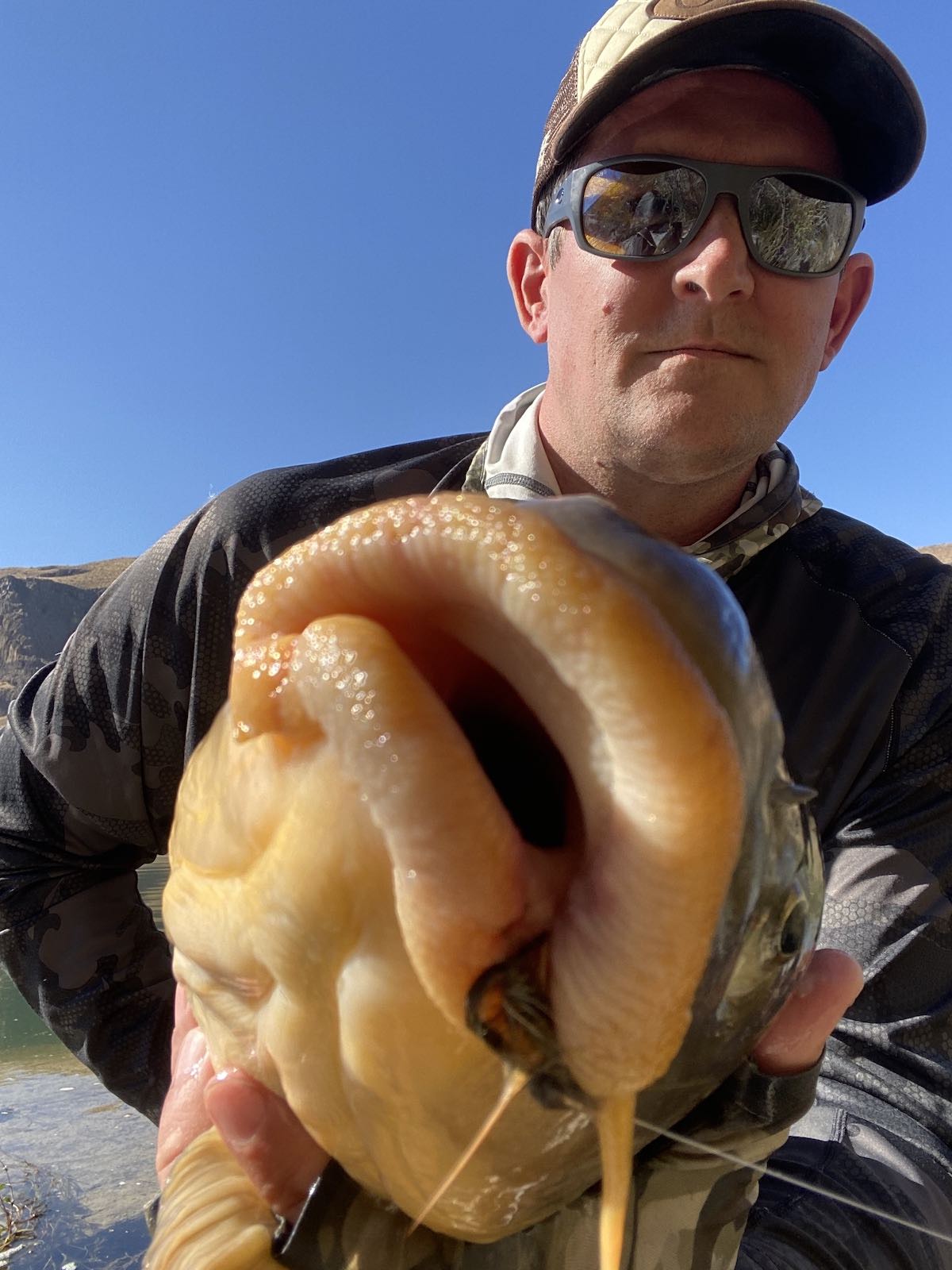
Where to find carp
There’s a small stream near me that I drive by almost every day—I don’t even think it has a name. It’s nondescript, shallow (12 to 24 inches) and clear, and maybe 15-feet across.
I pull over to gaze into its depths every few weeks, and I almost always see the same thing. There are 3-4 common carp grazing, several trout holding near the bottom, and a few juvenile largemouth bass hovering in weeds near the shoreline.
The carp are good-sized, and one of them is massive–a real monster. I often think about what fly I’d cast to them, and if they’d take it.
Here’s a picture of the stream I’m talking about–can you spot two carp?
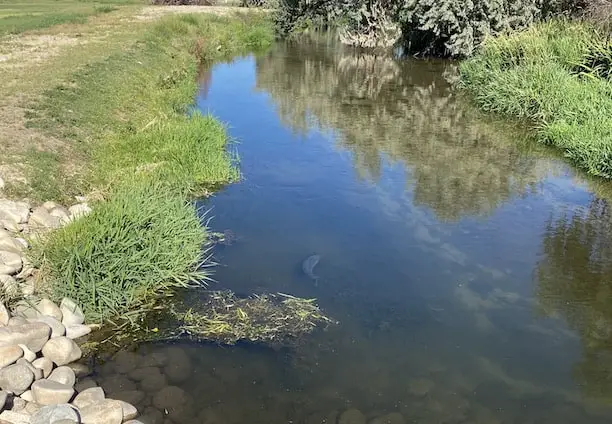
But, alas, it’s on private property.
Every state has different regulations regarding accessing streams and rivers—often related to the high water mark or whether the waterway was ever used for commerce. If you fish in Colorado, good luck. I recommend doing your homework, and respecting private property.
Landowners are often much more receptive to fly fisherman than hunters. So, just ask. I’ve heard that dairy farmers are almost always willing to allow fly fishing on their property.
Anyhow, back to locating carp.
Chances are you’ve got carp living in water close to you. Very close.
Common carp are found in all sizes and types of water: lakes, ponds, canals, rivers and streams. Don’t ever rule out a body of water without really checking it out. Carp fly fishing starts requires preparation and research. This isn’t just tossing corn.
Even the Great lakes, as gigantic as they are, offer some fantastic fly fishing for carp over their expansive flats. Lake Champlain, another gargantuan body of water, is a super place to target carp as well.
In all bodies of water, watch for carp foraging along the shoreline. You’ll often find them feeding in shallow water (6-36 inches deep), but they also want an easy escape to deeper water if necessary. So, look for shallow water (the shallower the better) that’s directly adjacent to deeper water.
Side note: Carp don’t always feed in shallow water, but that’s where you have the best chance to hook into them with a fly. I’ve seen carp feeding in water that was six feet deep on the Mississippi river, but when they’re that deep, it’s an order of magnitude more difficult to get a fly in front of them, so I recommend finding more accessible areas to improve your chances.
Sometimes carp are out in the open, and sometimes they’re in the weeds and reeds shuffling and digging.
In muddy or silty-bottomed waters, carp will often form mud trails or clouds as they disturb the substrate looking for morsels of food. Train your eyes to watch for these trails—they look just like you’d imagine they do.
In the below picture, I’ve added arrows showing mud clouds created by a carp. Yes, a single carp made all of the mud clouds in this picture after I spooked it and it bolted away–these clouds were created by the side-to-side motion of its tail as it bolted.
Despite the dirty water in this canal, I was able to get several carp to eat my fly.
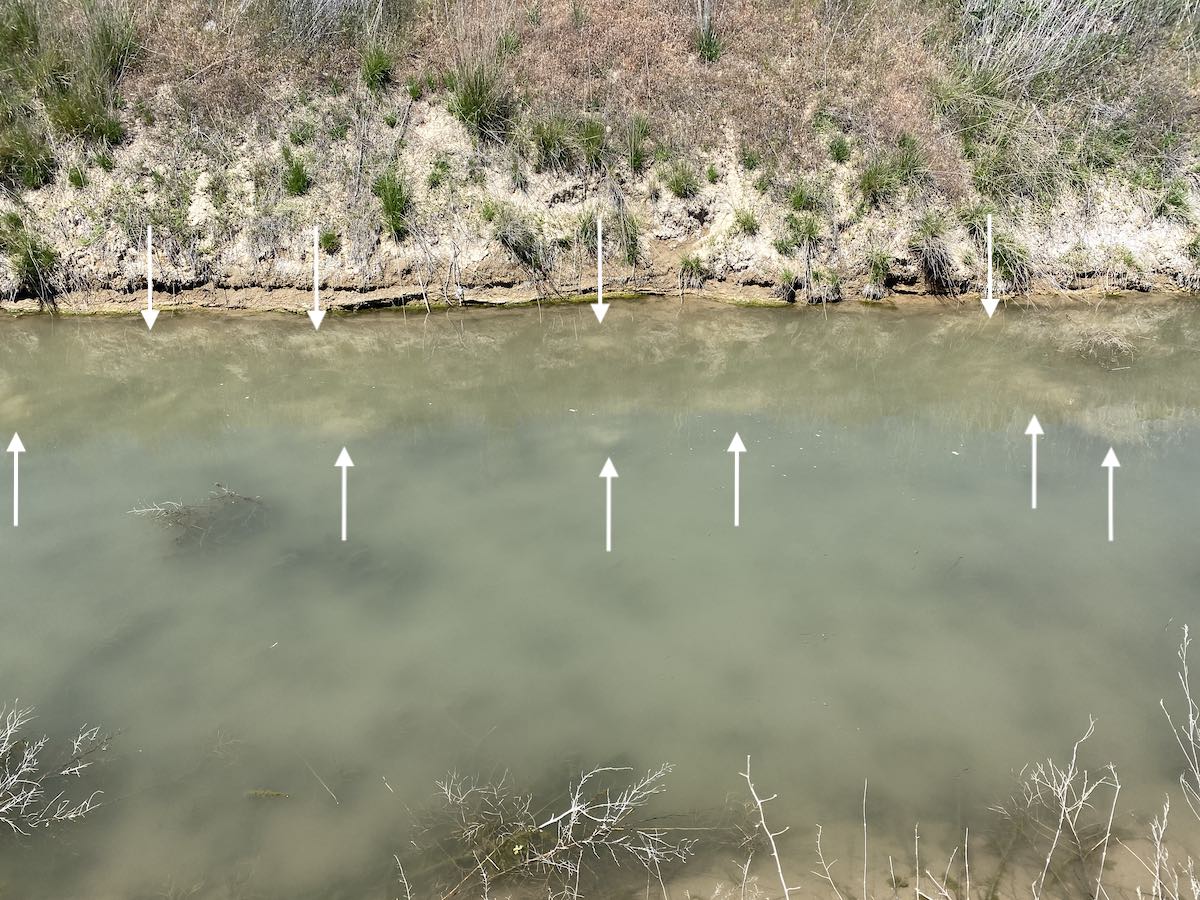
When I was around 18, my good friend worked for the state monitoring rare turtle populations. He explained to me what turtle nests looked like during one of our phone conversations, and I started seeing them everywhere when I’d go on walks around ponds.
Same concept here—learn what carp mud trails look like and you’ll start noticing them even when you’re not fly fishing.
Another telltale sign of carp is the slurping sound they emit when rising to food items on the surface (more on this later). Listen for it—refine your ability to pick it out of the ambient noise. Again, it sounds exactly like what you’d imagine a slurping carp sounds like.
Carp feeding at the surface is more common than you’d think.
Recently, I waded into a river—at the tail of a very wide and shallow pool—because I saw rising trout and wanted to cast some dry flies to them.
As I slowly inched closer to the fish, I saw that they were quite large, which was of course exciting. But, something didn’t add up—they were too big.
Once I was within about ten feet, I could see that all the rising fish were carp—not a single trout among them. But what were they eating on the surface? More on that later.
If you’re into fishing small bodies of water, check out my article on how to fly fish in ponds.
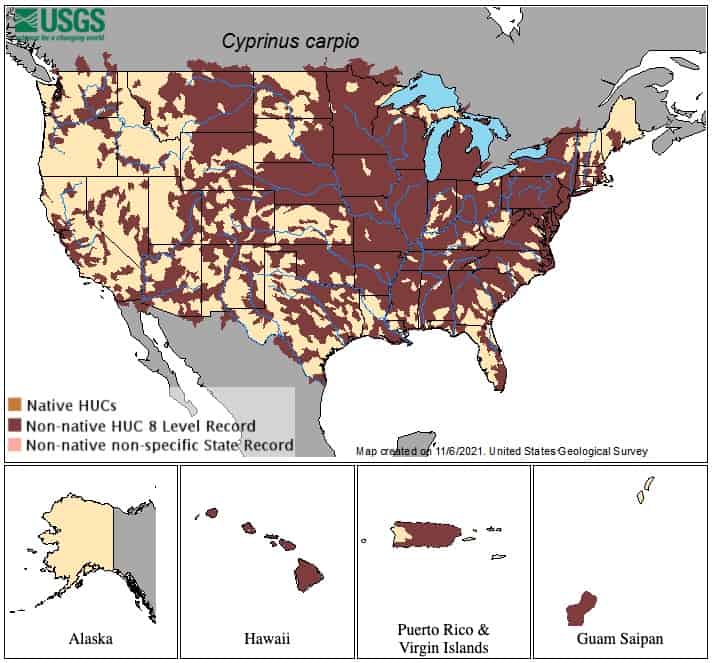
Common carp (Cyprinus carpio) U.S. range mapping
Here’s a map showing the distribution of common carp throughout the United States. As you can see, they’re an extremely prolific species.
carp fly fishing rods and reels
The best fly rods for carp are five and six weights, at a length of 9-feet. That’s my personal opinion. I like the softer presentation I can create with a less strout rod. I’ve landed more than a few 25+ pound carp on a five weight, and at no point have I ever felt like my rod was a liability during the fight.
A seven or even eight weight can work very well too–you just need to find your personal preference.
A lighter rod provides more sensitivity and a more delicate cast (carp spook easily), but a heavier rod will allow you to fight the fish faster, and will cut through the wind noticeably better when casting. It’s a trade-off.
When you initially hook into a carp, the first thing they generallly do is go on a long, hard run. Not always, but often. Use the butt of your rod to make them work during this initial run.
A nine or ten weight rod is overkill for carp.
Reel-wise, you’re going to want something that matches your rod weight. Make sure it has a good drag system, because you’ll need it. You’re likely going to catch carp that will take you into your backing.
Earlier this summer a big carp came unbuttoned while I was fighting it. Sure enough, the fish had bent the hook. The lesson: don’t use cheaply made flies.

carp fly line
Use floating weight forward or double taper line. Either will work just fine.
Keep in mind, the first +/-35 feet of double taper line has the same taper and shape as the first +/-35 feet of weight forward line. Personally, I use weight forward (WF) line exclusively.
I recommend using 4-6 feet of 0X to 3X fluorocarbon as your leader. My personal preferences is this line from Scientific Anglers.
1X line is 0.010” or .25mm in diameter, and has a break strength of 12.7 pounds (or 5.8kg).
Fluorocarbon line is stronger and less visible than monofilament line, but it doesn’t float as well as monofilament.
Similar to Largemouth bass, and unlike trout, carp aren’t usually leader shy. This means the diameter of your leader and tippet isn’t likely to spook them. So, use strong line.
Here’s a quick video showing a solid carp I caught while fly fishing the snake river.
How to catch carp on a fly
Ok, so we’ve gone over a brief history of carp, their size, appropriate gear, and where to find these fish. Now let’s talk about specific techniques to lure carp to your particular fly pattern.
Once you’ve located carp, it’s absolutely vital that you approach them quietly and slowly. Don’t fish while your dog is running up and down the shoreline because man’s best friend will spook all the fish.
Carp have poor eyesight, and maybe that’s why they’re so easily scared off. Yes, there are times when they don’t seem to spook no matter what you do, but that’s the exception, not the rule.
If you move too quickly along the shoreline, the carp will likely bolt, just like trout. Stealth is an absolutely vital aspect of carp fly fishing. Even feeding carp will stop what they’re doing and dart to deeper water if you disturb them.
If you fly fish for trout, you know that when you make waves as you wade through the water—even seemingly insignificant ones—the fish will spook. The same holds true for carp—they’ll spook and head for deeper water, if available. Working your way upstream will help mute any waves you create because the waves have to travel against the current.
Carp are also very alert to vibrations in the water—in other words, sound waves. They can feel sounds along their very sensitive lateral line, and with a special connection between their air bladder and eardrum.
Here’s a beast of a common carp I caught in a river in mid-May. The water temperature was 55F and the carp were in pre-spawn mode.
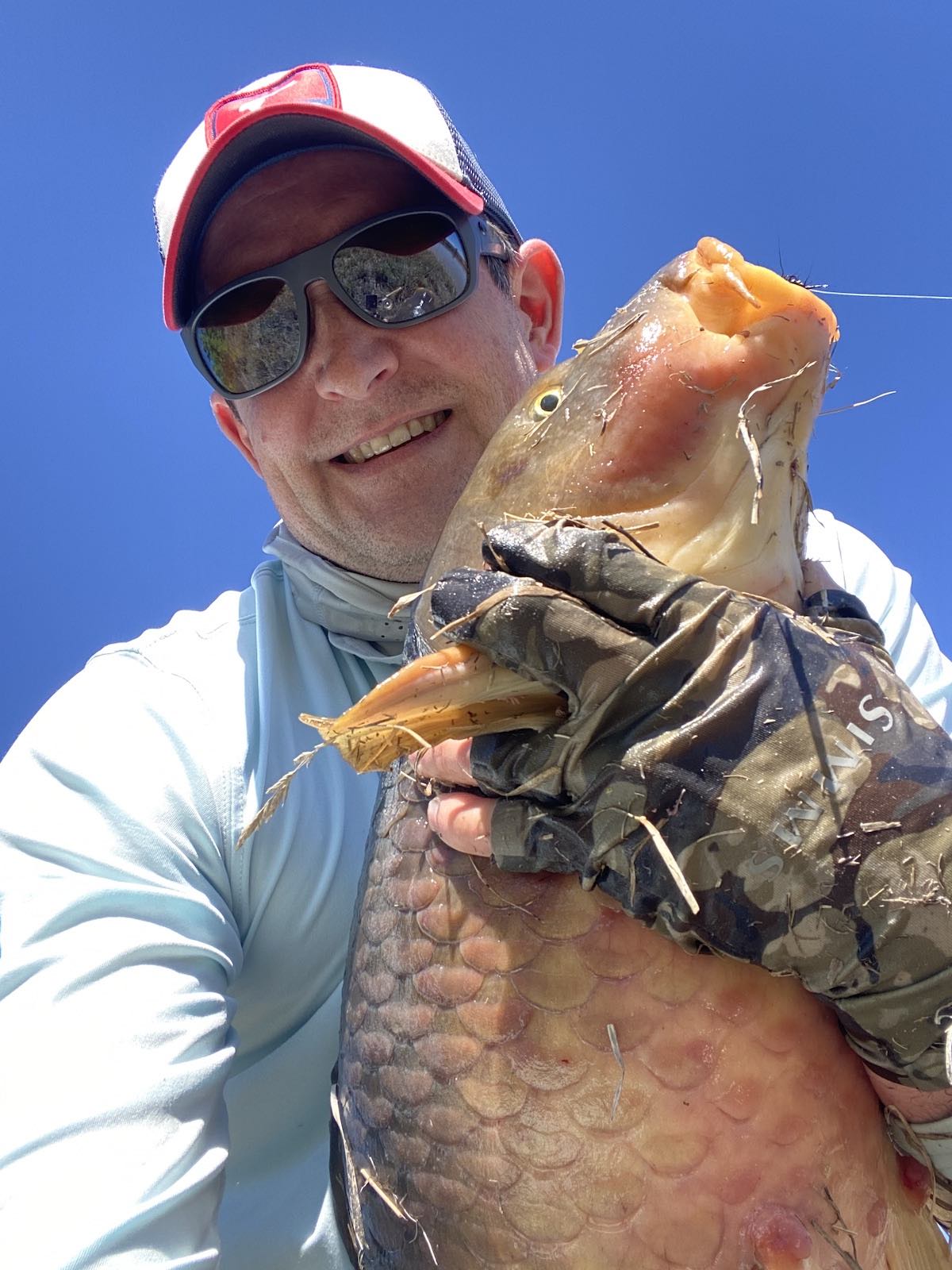
Here’s a picture of the same carp laying on the shoreline grass next to my fly rod. I released this behemoth seconds after I took this picture.
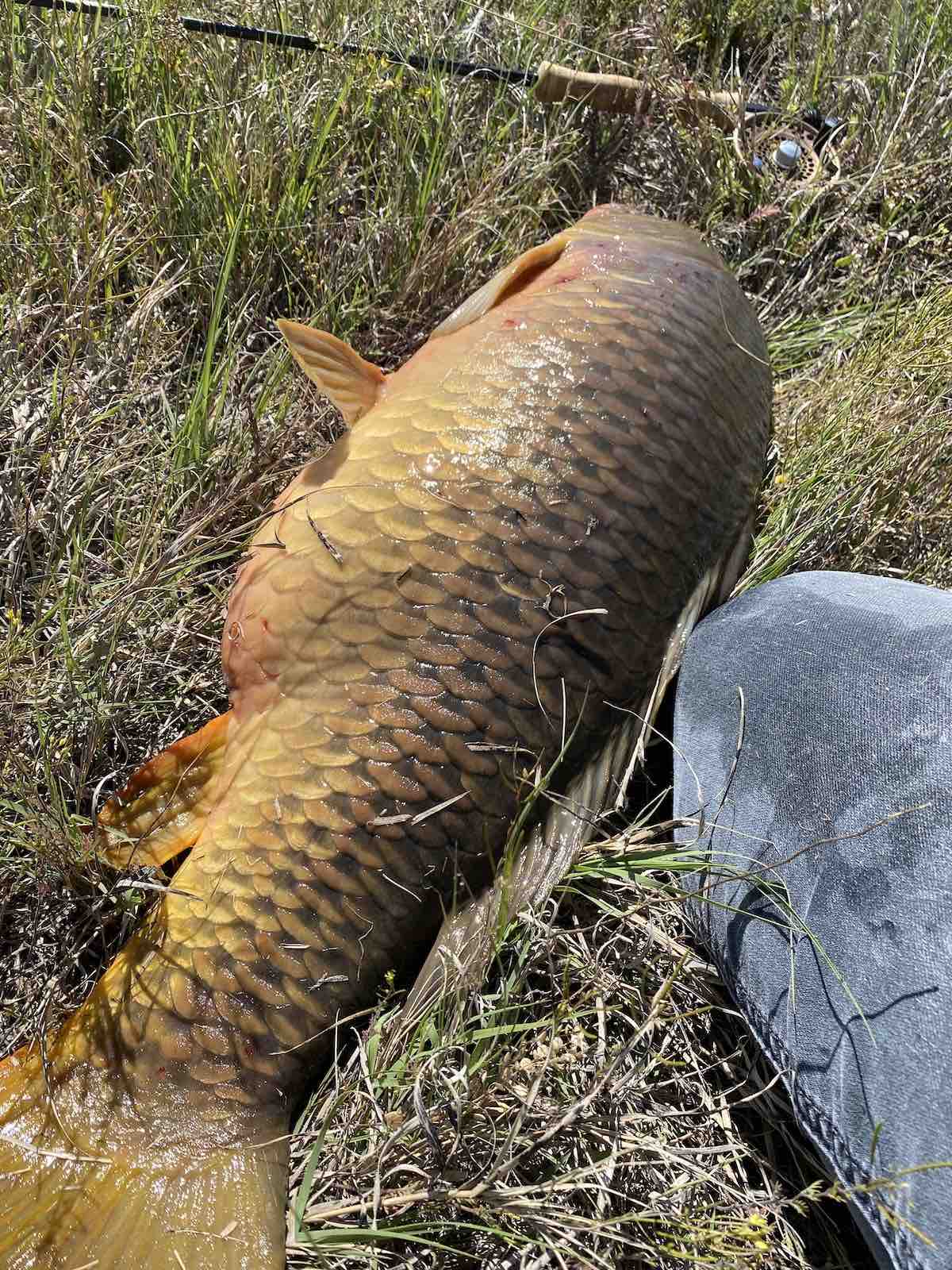
So, avoid being noisy with your fly fishing gear, and don’t yell to your buddy that you found some carp. I once witnessed a large number of carp bolt for deeper water when a big rig drove by approximately 100 feet away. Also, try not to roll rocks if you’re wading.
Most importantly, don’t let your fly line slap the water when you cast—especially if it lands on top of the carp. This’ll almost always spook them.
Speaking of carp, don’t miss my in-depth article on fly fishing for suckers. They’re a similar (and fun) species to target!
And if you’re into mega fauna on the fly, check out my article on fly fishing for arapaima in Brazil.
Remember this: you have to make the most of a carp sighting, because you’ll likely only get one or two chances to present your fly to the fish before it inevitably spooks. Occasionally you’ll get several shots at an individual fish, but this isn’t the norm.
When you observe carp from a bridge, for example, they seem big, slow, and aloof. I can assure you, however, that this isn’t the case. They’re highly alert, and can bolt nearly as quickly as a trout.
So, to reiterate the rules for stalking carp with a fly rod:
Move very slowly, and preferably upstream
Don’t make any waves, even small ones
Limit vibrations and sound
Don’t let your fly line slap the water near, or land on top of, the carp
By adhering to the above rules when approaching a carp, you can get considerably closer than would otherwise be possible. This is important because it allows you to provide a more silent presentation.
If you’re just 20-feet away from the fish, consider how much more softly you can present your fly, and with greater accuracy. Now imagine you’re 40-feet away—your fly line will hit the water with more force, and an accurate cast will be more challenging. It’s usually worth it to risk getting closer.
How should you approach a carp once you’ve spotted it? That comes down to personal preference.
I like casting at carp coming directly at me, or from the side. I don’t like casting from behind the carp, because it increases the chance I’ll line the fish (ie. my fly line, leader, or fly will land directly above the fish and spook it).
As you get into position, figure out which direction the carp is moving and cast your fly about 3-5 feet ahead of it, and slightly beyond it. (For the time being, we’ll assume the fish are feeding on the bottom, and not the surface.)
You want the fly to drift down into the carp’s feeding path. Specifically, try to get the fly to softly hit the bottom inside a 9-inch radius of the carp’s mouth. You’re leading the carp, anticipating its path.
Speaking of anticipating a carp’s path, it’s important to mention that carp rarely swim in a straight line. They even do U-turns. Trust me when I say that if you think a carp will zig, it will zag 80% of the time.
Once your fly is in the path of the fish (within the 9-inch radius of the carp’s mouth), instead of letting it sit motionless, you can very slowly strip it away like an escaping prey item. Alternatively, you can just slowly raise your rod. Same effect. The carp may chase the fly and inhale it. Carp have relatively poor eyesight and this movement can trigger their interest.

PRO TIP: Carp have eyes on the sides of their head, which means they have a blind spot directly in front of them. So, try to position your fly (or flies) accordingly.
If possible, don’t false cast over the fish. False casting can spook carp just like it spooks trout. I almost never false cast when I’m chasing carp.
Carp often test potential food items, but it doesn’t take them long. It can take carp less than a second to spit out your fly (ie. non-food items). The most reliable method to determine if a carp has taken your fly is if you see the fish subtly swing or jerk to the side. Also, if you see the carp’s lips extend (inhaling your fly), or a gill flare, you’ve got to be ready to set the hook.
I generally use a trout-set (setting the hook with my rod) when the carp is within 30 feet or so, which is almost always the case. If you prefer a strip-set, go for it. Regardless, a carp that inhales your fly will most likely deeply set the hook itself by making a strong run in the opposite direction.
The more you fly fish for carp, the better you’ll get at recognizing takes. It’s an art, not a science. It takes practice and an observant eye.
Over time you’ll learn the highest probability casts. For example, tailing carp are always your best bet. Feeding carp are looking for a meal.
If you ever see a carp sunning itself, which means it’s floating almost motionless at the surface, cast your fly in front of its head. You’ll be amazed how often they’ll take your fly.
Here’s another tip: if you ever see a carp swim towards your fly and stop over it, set the hook immediately. This is often signified by the pectoral fins flaring out.
When a feeding carp takes your fly, the first thing it’s likely going to do is make a long run for deeper water. The run can be long and might get you into your backing, depending on the carp’s size. Once the fish stops running, it’ll stubbornly hold the bottom.
Finding carp feeding on the surface is pure serendipity. But, the vast majority of the time, carp feed on the bottom.
What foods do carp rise to?
Cottonwood seeds for one. If you live near an area with cottonwood trees, keep an eye out for seed season. If you want to keep things simple, use a fly called a light cahill, since it resembles a cottonwood seed. Or any white-colored dry fly. Some places do offer cottonwood imitation flies.
If you don’t live in the vicinity of Cottonwood trees, try locating some Cattails. They’re everywhere. Carp rise to cattail seeds as well.
When fly fishing for carp—you want to match the hatch, just like with trout. If they’re feeding on berries that have fallen into the water (such as mulberries), find something that looks as similar as possible to a mulberry. Keep a red sharpie with your fly gear, and you can use it in a pinch to color your carp flies.
Don’t be afraid to trim your flies with snips so they more closely mimick what the fish are eating.
There are public bodies of water where timed mechanical feeders drop pellets into the water at predetermined times of the day. I’ve never seen one of these, but I’ve heard stories about them.
My guess is, the pellets aren’t intended for carp, but the carp find them, and they learn the schedule too. How would you match the hatch when carp are feeding on floating pellets? Well, there are flies in existence that specifically imitate pellets, aimed at catching hatchery trout. I’ve never used one before, but if I saw carp taking pellets, you can bet I’d try.
One more tip: if you want to catch a carp on a fly, try visiting golf course ponds. Don’t trespass, though. It’s important that fly fishers foster and maintain a positive reputation.
Why golf course ponds?
Golf course ponds contain carp with surprising regularity. I’m not a big golfer, but I get out a few times each year.
A few days ago, my family and I visited a golf course we’d never been to before for some twilight rate golf. Sure enough, I saw carp in the ponds. Unfortunately, I also saw that fishing wasn’t allowed.
The best part about golf course ponds is that the lawn mowers blow grass clippings into the water. The carp in these ponds will then skim the grass off the surface. How would you catch these golf course carp? You could tie fly that resembles a clump of grass. Or, if you don’t tie flies, you could purchase an extended body green drake fly, which has worked well for me quite a few times.
If you golf somewhat regularly, it might be a good idea to get to know the greenskeeper, or one of the rangers.
There’s a common saying in trout fly fishing circles: “follow the foam” or “the foam is your home.” While this tenet is specifically related to casting into the foam line, the same concept holds true for carp. The foam not only provides cover from above, but it tends to trap edible insects as well.
It’s not uncommon for carp to congregate beneath foam, so try casting into or near foam any time you see it.
During the winter months, carp head into deeper water. It’s essentially infeasible to fly fish for carp when they’re deep, or when the water temperature is approaching freezing. It’s honestly best to chase other species during the winter season.
HOW TO CATCH SPAWNING CARP
Many folks new to targeting carp with a fly are ecstatic to see actively jumping carp, but absolutely confounded as to why they can’t get a hook into one.
You’ll generally only see jumping carp during their spawning season—a time when they’re not focused on feeding.
Some people think jumping carp are simply rinsing their gills free of silt and parasites, but in my experience they mainly jump during the spawn.
Regardless of the reason, jumping carp don’t seem interested in taking a fly.
If you see flashes near the bottom of the waterway, those are female carp expelling eggs. They’re not feeding carp, they’re focused on spawning.
PRO TIP: It’s conventional fishing wisdom (which is often incorrect) that spawning carp won’t take a fly. This is not true.
There are almost always stragglers that are willing to eat. You’ll recognize these fish because they’re generally loners–you should focus on them during the spawning period. The slower the carp is traveling, the better the chance it’ll take your fly.
Now, in my experience, daisy-chaining carp have nearly zero interest in a fly. These are lines of carp 2-5 fish long, and they usually swim briskly. They seem to have only one thing on their mind: reproduction.
Get creative and try new methods. Every carp is different; no two of them have the same DNA. Try new things. Prospect in new areas.
I can guarantee you’ll be pleasantly surprised.
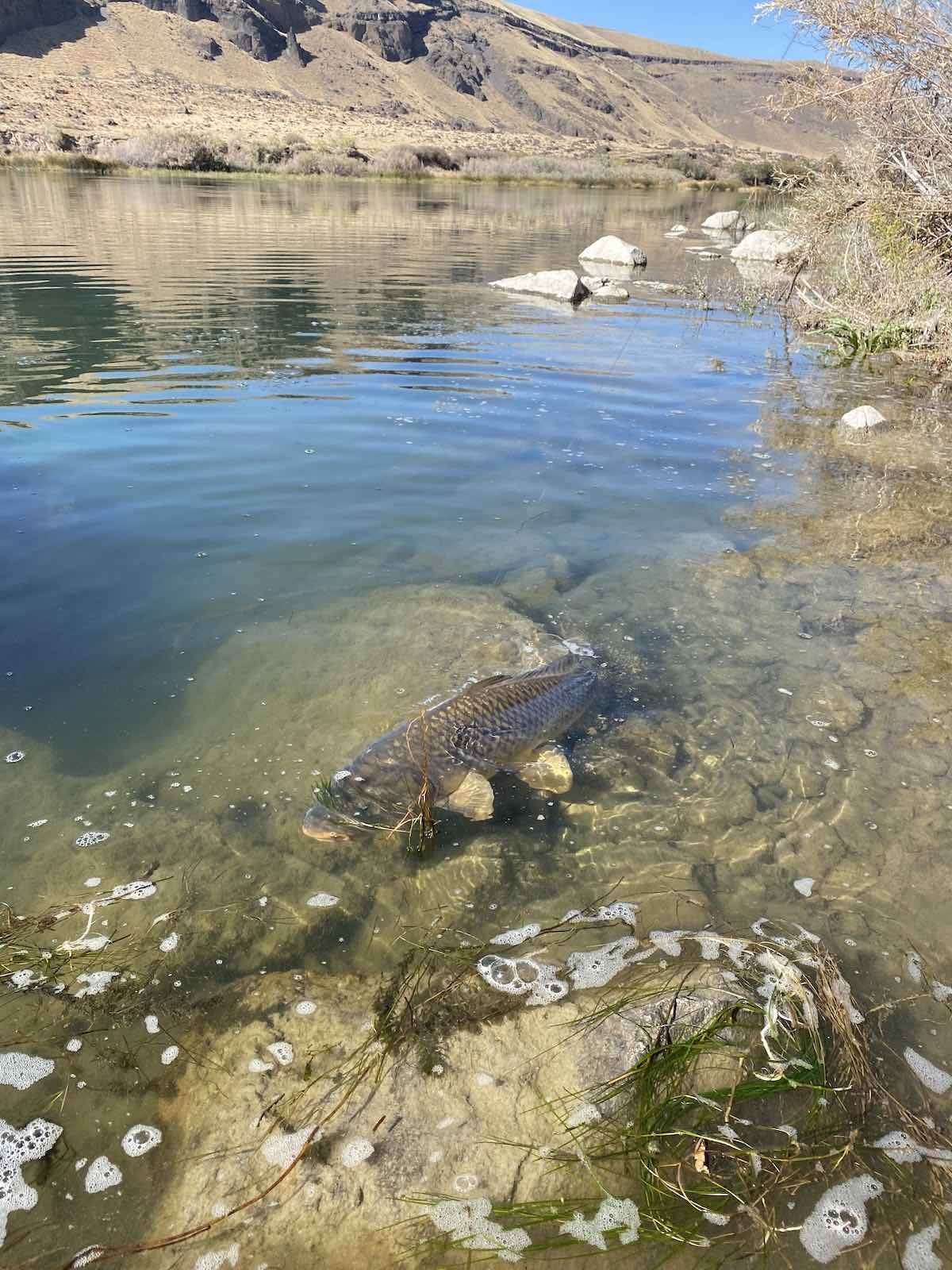
This was an exciting moment. I’d just hooked into a huge carp on the fly in several feet of water, and was able to guide it into the shallows after a very long +/-125 foot run. I wasn’t targeting carp on this day, and was using my 5-weight rod and a size 14 beadhead tan woolly bugger.
The best carp flies
Let’s reiterate a main point: the most productive carp flies are going to match the hatch, so-to-speak. The “hatch” might be crayfish, grass clippings, cottonwood seeds, sub-surface insects such as damselfly nymphs, surface insects, various plant-matter, mollusks (clams), or minnows. Few fish you can target with a fly have diets as varied as carp.
As a general rule, the best carp fly pattern colors are orange, rust, brown, and black.
Special Tip: Don’t be afraid to try a double-fly setup. In other words, tying on two flies.
Another general guideline is if you’re in slow water, use less weighted flies. In faster water, use flies with more weight to get you down to the fish faster.
In the following section, I’ll go through several carp fly patterns that have proven very successful for me, and will produce for you as well.
Leech Pattern – Perhaps my favorite fly for carp is a small black leech, size 10-12. I like a small beadhead so that it sinks slowly. You generally don’t want a fly that’s going to rocket to the bottom. You can get my favorite pattern at Trident.
Egg Pattern – Sliding one of these flies in front of a carp is a high probability scenario since they’ll often test it. Orange is my go-to color. Try it.
Crayfish – Crayfish patterns and fly fishing for carp–the two go hand-in-hand. There are quite a few crayfish fly patterns out there, and most of them are acceptable imitations. Sometimes they’re called crawdads—same thing. Just make sure the fly you use has enough weight to be fished directly on the bottom.
Use these flies wherever you know crayfish exist. This is usually in streams and rivers, but not always. These crustaceans like rocky bottoms where there are plenty of crevices for them to hide in.
Crayfish are a favorite food of carp, so don’t avoid these flies just because they’re a little clunky. Sizes 6-10 are perfect.
Woolly Bugger – If I could only use one fly for carp, it’d be a black woolly bugger. If you’re serious about carp, do yourself a favor and buy an assortment of Woolly Buggers. This fly can imitate so many things—a minnow, a crayfish, a stonefly or large insect—they’re incredibly versatile. You really need to have these in your carp gear.
They come in all the popular carp colors, and there are beadhead and non-beadhead styles readily available, depending upon conditions. They can be fished at any depth, or bounced off the bottom. Again, super versatile.
I recommend these flies in sizes 6-10, and I highly suggest having variations of each color, as well as beadhead and non-beadhead versions.
Nymphs – When carp are foraging in the mud, nymphs are often the way to go. Specifically, a beadhead version so you can get the fly positioned on the bottom. Give it a little action as the carp approaches.
The pheasant tail and hare’s ear nymphs have worked well for me, but I’m convinced the carp would take any nymph that’s relatively similar in appearance, such as a prince nymph.
If carp are taking nymphs, I don’t think they’re examining the pattern too closely (poor eyesight). Keep sizes 12-14 in your carp fly box.
General Gear
A great slingpack or backpack is an invaluable piece of equipment for any angler. If you’re curious, don’t miss my article on the best fly fishing slingpack I’ve ever used (and I’ve used quite a few).
Will Carp Eat Dry Flies?
Absolutely!
But there’s a caveat: timing is everything.
One early summer day I was scouting some water, scanning for fish. It was then that I noticed a huge carp rise to the surface and eat a cottonwood seed. I knew they ate cottonwood seeds, but I’d never seen it in person.
I then noticed two large cottonwood trees (they get huge) dropping their seeds all over the surface. I did some more searching, and found a pod of around 20 carp all rising to cottonwood seeds. What a sight!
Tying on the closest thing I had to a cottonwood seed pattern, I landed three carp in about two hours.
I kept going back to this spot over the ensuing several weeks, and the carp were always there. That is, until the cottonwood trees finished spreading their seeds, and then the carp were gone. It makese sense, but this is why I say timing is everything.
Pay attention to when cottonwood seeds are in the wind. And, if you live in an area with mulberry trees, notice when the berries begin dropping. Carp love eating mulberries.
Here’s one of many carp I caught on cottonwood seed patterns this past summer, some of which I tied myself (it’s easy).


Some carp will even take a hopper pattern, especially if it mimics something they regularly eat. Here’s a carp I caught on a cicada pattern.

Here’s one of many carp I’ve landed on a black leech pattern. Cast ahead of the fish, let it sink ito the zone, and give it a small amount of movement.

Grass carp vs Common carp
Let’s take a moment to go over some differences between grass carp and common carp.
The biggest difference, as it relates to fly fishing, is that grass carp prefer to consume vegetation. Notice that I didn’t say they only eat vegetation. This is a common misconception.
Contrary to what many people think, grass carp will eat insects, crustaceans, and minnows as well, making them omnivores. Common carp are also omnivores, but they prefer animal matter over vegetation.
Grass carp are not generally leader shy, just like common carp, but they’re much more easily spooked than common carp.
The mouth of a grass carp is bony, while common carp have soft, rubbery mouths. So, grass carp require a more firm hook set. Grass carp also don’t have the barbels (aka whiskers) that common carp have on either side of their mouth.
Grass carp feed primarily on the surface of the water, or just below the surface, while common carp are more focused on the bottom.
Common carp are more stout and thick, while grass carp are more thin and slender. But, both species attain huge sizes.
Summary
Fly fishing for carp is gaining popularity with each passing year, and these fish certainly deserve the recognition. I challenge you to hook into a large carp with a fly—adrenaline pumping, hands trembling, wondering if your rod is going to snap—and not confess it’s one of the most exciting experiences you’ve had on the water.
If you’re into hard-fighting fish, and who isn’t, check out my article on how to fly fish for smallmouth bass.
Specifically fishing for carp with a fly rod is still a nearly unheard-of pastime for most fisherman. We’re a long way from seeing shores crowded with folks casting flies to carp. It’ll never be mainstream, but that means more fish for you and me.
Carp have endured decades of condescension from fisherman—especially fly fisherman. The guys wearing tweed jackets and smoking pipes would’ve never lowered themselves to chasing carp. They thought the same thing about bonefish. But that’s truly their loss.
As a kid it was instilled into me that carp were a nuisance; they were worthless. The disappointment of seeing a carp on the end of my line was almost as frustrating as seeing a bullhead.
Fast forward to today, and imagine the serendipity of realizing these fish are in fact unimaginably fun to pursue with a fly. Carp fishing opens up an entire new world to explore.
Now get out there.
P.S. When you catch a carp using tips from this article, please email me a picture of it!
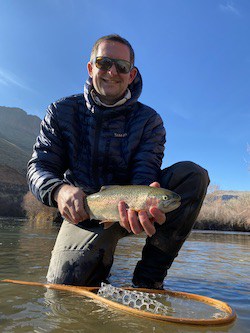
About the Author
My name's Sam and I'm a fly fishing enthusiast just like you. I get out onto the water 80+ times each year, whether it's blazing hot or snow is falling. I enjoy chasing everything from brown trout to snook, and exploring new waters is something I savor. My goal is to discover something new each time I hit the water. Along those lines, I record everything I learn in my fly fishing journal so I can share it with you.
Follow me on Instagram , YouTube, and Facebook to see pictures and videos of my catches and other fishing adventures!
